Friday, September 23, 2011
 This is a text-only version of making fresh tomato sauce. For a cooking video, click here.
This is a text-only version of making fresh tomato sauce. For a cooking video, click here.
I love summer for its glorious tomatoes, when there’s no better time to make homemade sauce. There are lots of options to make it your own, and this basic tomato sauce recipe has tons of applications from pairings with pasta and beyond. Please do heck out my recipe page for tons of ideas for using this sauce (like, say, grilled vegetable parmigiana) and join me in one of my favorite summer cooking projects!
Fresh Tomato Sauce
Start with a slew of tomatoes. I used 10 large beefsteak tomatoes and 9 heirloom red zebra roma tomatoes, as shown. (They cook down. A lot.) Feel free to select those that suit you and/or chat with your local farmer about which make the best sauce. I personally like to keep to 2-3 varieties or so, making sure at least one of them is roma, which are meaty, thick, and classically used in tomato sauce.
Begin with chopped onion (I used 1.5 large yellow onions) and sauté in medium heat with EVOO – extra virgin olive oil – until soft but not browned. (I’m going to have to use that acronym, along with everyone else. Just easier.) Add veggies of your choice. I like red and green bell peppers, and used one of each, but sometimes I like to make a more serious veggie version that includes zucchini and eggplant, especially if my main use will be as a pasta sauce. Olives are also a great addition, if you like them. If you like it spicy, you could also use a chile pepper in here as well at this point, or poblano peppers in lieu of the green bell. I do whatever I’m in the mood for, and so should you!
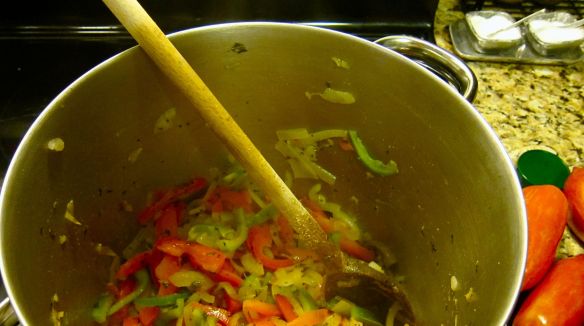
While the veggies are cooking, ~8 minutes, chop or dice the tomatoes to the size of your liking. I prefer a chunky tomato sauce, so I do a small-medium chop. If you don’t feel like chopping so many tomatoes, you could always throw some of them into a food processer, similar to what you’d get from crushed tomatoes in a can. Be careful, though, as they will thin out considerably during this process, but it’s fine. If you start making homemade sauce, play around with chopping/dicing/food processing and you’ll figure out what you like and how much time you feel like investing to get the desired result. I personally enjoy chopping vegetables, but I know lots of people hate it. (And there’s always canned crushed and diced tomatoes and frozen veggies if you want to spend even less time. Still better for you and the planet than store-bought.)
After the veggies are tender, add chopped garlic to the pot and stir for about 45 seconds; I love garlic and used 5 cloves or so. Up to you. It takes very little time to cook garlic, so don’t let it burn. I also add some other spices at this point, such as oregano, basil, parsley, crushed red pepper flakes, and salt and pepper. Again, this is all to taste, but I’ll remind you not to add too much salt, because you can’t go back and with all the big flavors in there you don’t need as much as you think. I’d start with 1 teaspoon or less—depending on how many tomatoes you are using—and adjust later as necessary. (It will also be perfectly lovely if you don’t add salt at all, by the way; I’ve made it that way, too.) I also added some fresh basil and parsley (chopped) at this point, along with a few tablespoons of tomato paste for good measure, which adds both intense tomato flavor and body.

Add all the chopped tomatoes and stir everything up. Pour in some red wine (or balsamic vinegar, if you don’t consume alcohol), about 1/4 to 1/2 cup depending on how much sauce you are making and your own preferences. Bring everything up to a boil, then turn the stovetop down to simmer. It’s looking good at this point, but now everything needs to cook for awhile, which is when a lot of that water will leave the dish and it will thicken up. Give it as much time as you can, remembering that the bigger the batch you make, the more time it will take. We’re talking about hours here. If it’s a smaller batch, an hour could suffice, but the longer it simmers, the tastier and thicker the sauce will be as the flavors develop and the sauce reduces. And it really does reduce substantially over time. In about 1.5 hours the height of my sauce dropped by around 1.5 inches. Seriously.
Stir the sauce every 10-15 minutes or so and make sure it continues to simmer actively, which is needed for it to reduce. You’ll note that it looks somewhat watery on the top, since water is less dense than the sauce contents below. In other words, it’s supposed to look that way and will do so between stirrings. Don’t cover the pot: you need the steam to escape for the sauce to thicken. Note that people differ in their tastes for a “thick and rich” tomato sauce versus a “fresh and chunky” tomato sauce. If your sauce is not as thick as you would like, you have a couple of options. The first is to make quick marinara as shown here (i.e., purée some of your tomatoes in a blender to create a “crushed tomato” effect rather than to only add chopped, as pictured below). Or, just add tomato paste (a few tablespoons, up to about 1/2 cup), which will thicken it up quite nicely. You would add this alongside the chopped tomatoes.
You’re almost there, but don’t forget to sample the sauce along the way! Tasting is a critical component of cooking. Does it need more seasoning? Not sweet enough? Adjust the spices as you like, and sometimes I’ll add a little honey to balance the flavors and acidity but it depends on how sweet the tomatoes were to begin with. I also usually add a little more wine along the way as well (but that’s just me…). Finally, if you like a less chunky sauce, get out the blender—a hand / immersion blender is easiest and it’s a fantastic kitchen tool to have, er, on hand—to obtain a more homogeneous texture, or simply to get it less chunky. Make it however you like it! It’s your sauce, after all.
When everything is done, I often add some fresh parsley, basil, and/or oregano to brighten up the flavors. It will give the sauce some earthy, herbal notes, so whether you like that or not is up to you. And remember there are so many variations on this that you can make. Spicy pepper is one of my favorites, but I also mentioned I sometimes use zucchini and eggplant. Mushrooms. Olives. Sometimes just tomato and basil. Whatever.
So there you have it. Make it as you like. Make it your own. Make it this weekend.
—
2015 update: The final sauce in photo at the beginning of the article is actually marinara, because I was able to retake the photo years later on a day I had better lighting. If you did a very basic tomato sauce with no added veggies it could look like this, and I’ve also shown what my finished product (with peppers, etc.) simmering on the stovetop usually looks like in the above photo.

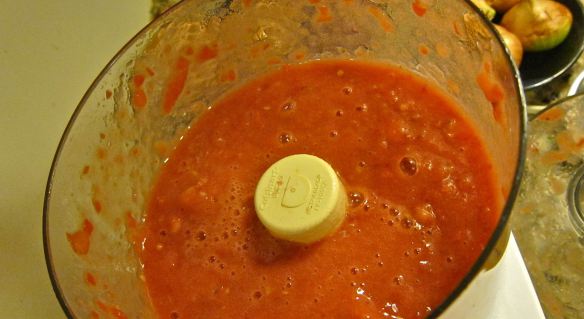
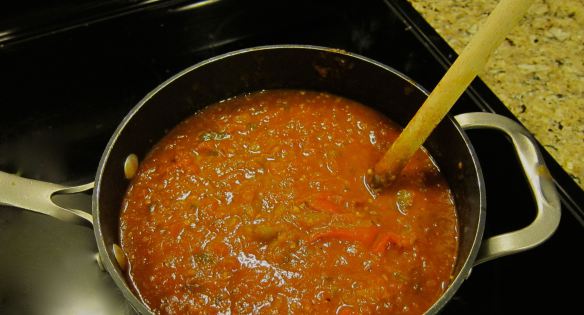
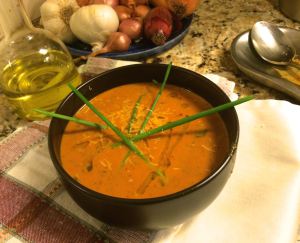
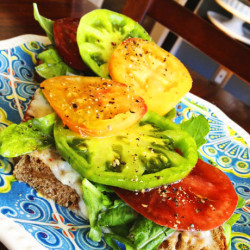
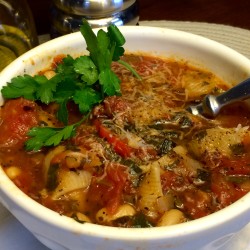

ok you’ve inspired me to go to my farmer’s market tonight right before they close and make some tomato sauce. ME!! Can you believe it?
Yay! Keep me posted….I was just thinking this evening that I forgot to add my last line, which was “And let me know how it turns out if you do.”
So, er, do. Let me know how it turns out, that is. It’s really a combination of art and science ;).
This is probably pushing things – I’m not sure – but all I can say is that there are lots of excellent varieties of whole wheat pasta out there. It’s a bit of an acquired taste, depending on your palate, but give it a shot at some point if you haven’t already. I was initially resistant as well (years ago) but got really, really into it and now can’t go back.
Anyway, you might have just made my night, or something ;). So thank you for writing!
Also: HAVE FUN! 🙂
Reblogged this on The Nutrition Doctor is In the Kitchen and commented:
This is my first-ever reposting of a piece I wrote previously, as it was really early on and most of my readers will not have seen it. Plus, in linking back to it this past weekend I took the opportunity to add some lovely photos to further assist you. Now that tomato season has officially arrived here in New England, I’ll be making up my first batch of the season very soon. So delicious, so satisfying, maybe it’s time for you to give it a shot, too!